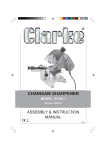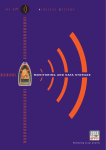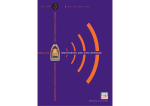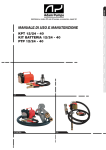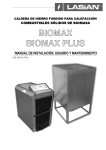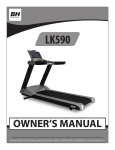Download Clarke WCP150 Instruction manual
Transcript
PROFESSIONAL WIRELESS WEATHER STATION MODEL NO: WCP150 PART NO: 4201004 OPERATION & MAINTENANCE INSTRUCTIONS LS0409 INTRODUCTION Thank you for purchasing this CLARKE Professional Wireless Weather Station. Before attempting to use this product, please read this manual thoroughly and follow the instructions carefully. In doing so you can look forward to your purchase giving you long and satisfactory service. GUARANTEE This product is guaranteed against faulty manufacture for a period of 12 months from the date of purchase. Please keep your receipt which will be required as proof of purchase. This guarantee is invalid if the product is found to have been abused or tampered with in any way, or not used for the purpose for which it was intended. Faulty goods should be returned to their place of purchase, no product can be returned to us without prior permission. This guarantee does not effect your statutory rights. IN THE BOX QTY DESCRIPTION QTY DESCRIPTION 1 Base Unit 2 Mounting Brackets 1 Main Sensor/Transmitter Assembly with Removable Cover 2 Hose Clips 1 Wind Speed Rotor Assembly 3 Cable Ties 1 Rain Gauge Assembly 1 Fixings Pack 1 2 Section Mast 1 Instruction manual ENVIRONMENTAL PROTECTION Please ensure batteries are disposed of safely. Never dispose of batteries in the fire or with household waste. Check with your local authority for disposal regulations. 2 SET UP NOTE: Use good quality alkaline batteries. 1. Have the indoor weather station and remote temperature sensor close together during setup. 2. Install the batteries into the remote sensor first, then into the weather station. See below. INSTALLING THE BATTERIES REMOTE SENSOR (FIG 1) 1. Remove the battery compartment cover. Fig 1 2. Insert two alkaline AA batteries into the remote sensor. NOTE: Make sure that you follow the polarity diagram inside the battery compartment. 3. Replace the battery compartment cover. INDOOR BASE STATION (FIG 2) 1. Remove the battery cover. Fig 2 2. Observing the correct polarity, install three alkaline AA batteries. 3. Replace the battery cover. 4. Do not press any buttons for at least ten minutes. This will allow time for the weather station to start receiving information from the sensor, • If successful the indoor weather station will show the sensor temperature and humidity. • If the indoor weather station does not display these values after 1 minute, the signal search will try again every two hours until a signal is found. • Once the remote sensor temperature and humidity values are displayed for 10 minutes you can place the sensor outdoors. 3 RADIO TIME SIGNAL After the initial setup period, the weather station will start to search for a radio time signal. In the UK the time and date signal is sent by a highly accurate governmentoperated atomic clock. The weather station will continually scan for the radio controlled time signal each day. • If reception is unsuccessful, then the radio time signal icon will not appear and the manually entered time will be displayed. See page 9 for instructions on how to enter the time manually. • If reception has been successful, the radio time signal icon will be shown and the received time and date will overwrite any manually set time and date. ASSEMBLY SENSOR MAST FITTING THE WIND SENSOR (FIG 3) 1. Slide the wind sensor onto the mast as shown. 2. Secure the wind sensor using the Ø2.2x8 mm screw and Ø3x25 mm bolt and nut supplied. Fig 3 3. Make sure the wind sensor can rotate freely. FITTING THE RAIN SENSOR (FIG 4) Fig 4 1. Remove the four bolts on one of the support arms. 2. Fix the support arm to the mast as shown, replace the bolts. 3. Place the rain sensor onto the support arm and secure it using the Ø2.6x10 mm screw supplied. 4 CONNECTIONS (FIG 5) 1. Connect the wind and rain sensors to the Thermo-Hygro sensor as shown. Fig 5 FITTING THE THERMO-HYGRO SENSOR Fig 6 TO THE MAST (FIG 6) 1. Loosen the four bolts on the second support arm. 2. Fix the support arm to the mast as shown and retighten the bolts. 3. Place the thermo-hygro sensor onto the support arm and secure it using the Ø3x20 mm screw supplied. 4. Slide the cover over sensor as shown. OUTDOOR FIXING (FIG 7) Fig 7 1. Route the wires neatly and secure into position using the cable ties supplied. 2. Fit the mast to a fixed pole using the 2 jubilee clips provided. IMPORTANT: For accurate readings the sensor mast should be mounted in an open area away from trees or coverings which may affect wind and rain measurments. 5 BASE STATION Fig 7 • There is a folding stand at the rear of the base station, which allows the unit to be stood on any flat surface. • The base station may also be wall mounted using the hanging hole on the rear of the unit. NOTE: It is important to check that the radio signal can be received at the chosen location before permanently mounting either of the units. 6 LCD OVERVIEW 7 USING THE WEATHER STATION WEATHER FORECASTING Sunny Partly Cloudy Cloudy Rain The four weather icons Sunny, Partly Cloudy, Cloudy and Rain represent the weather types. NOTE: Weather forecasting is based upon the change of air pressure.The pressure threshold can be adjusted from level 2-4 (default level 2). See “General Settings” on page 10. Areas that experience frequent changes in air pressure require a higher setting. WEATHER TENDENCY ARROWS The weather tendency arrows are located between the weather icons and provide a forecast of the weather you can expect. • Arrows pointing to the right - mean that the air pressure is increasing and the weather is expected to improve. • Arrows pointing to the left - mean that the air pressure is decreasing and the weather is expected to deteriorate. EXAMPLES OF CHANGING WEATHER ICONS: This is based upon the current pressure and the pressure change over the last six hours. • If the weather is changing, the arrows will flash for three hours indicating changing weather. • If the weather conditions become stable, then the arrows will not flash. 8 STORM WARNING When there is a fall in pressure (above the threshold) over a period of 3 hours, the storm warning feature will activate. • The “cloud with rain” icon and tendency arrows will flash for 3 hours indicating the storm warning feature has been activated. NOTE: The storm threshold can be adjusted by the user from 3-9hPa (default is 4hPa). See page 10. SETTINGS • Display Settings • General Settings • Alarm Mode • Min/Max Mode You can return to normal mode at any time by either pressing the SNOOZE/ LIGHT button located on top of the unit, or waiting for 10-seconds without pressing any buttons. DISPLAY SETTINGS The display settings mode allows you to select what is displayed either outdoor temperature or dew point and absolute or relative pressure. 1. Press the SET button once. • Outdoor temperature / Wind chill / Dew point will start to flash. 2. Press the MIN/MAX button or + button to select between Outdoor Temperature / Wind Chill / Dew Point. 3. Press the SET button again to make the selection. • Absolute pressure / Relative pressure will start to flash. 4. Press the MIN/MAX button or + button to select between Absolute Pressure and Relative Pressure. 5. Press the SET button again to make the selection. • Wind speed / Gust speed will start to flash. 6. Press the MIN/MAX button or + button to select between wind speed or gust speed. 7. Press the SET button again to make the selection. • 1h / 24h / week / month / total will start to flash. 9 8. Press the MIN/MAX button or + button to select the period you want to measure rainfall over. NOTE: When total is selected, pressing SET for 2 seconds will reset the total to zero. 9. Press the SET button again to make the selection and return to normal mode. GENERAL SETTINGS 1. Press and hold the SET button for 3 seconds or until the base station beeps to enter the “general settings” mode. 2. Press the SET key again to cycle through the following settings. • Time Zone Setting: the default time zone setting value is -1 based on Germany DCF time (GMT +1) • 12/24 hour format • Manual time setting (hours/minutes) • Calendar setting (year /month /date) • Temperature display unit (degrees Celsius or Fahrenheit) • Air pressure display units in hPa (hectopascals) or inHg (inches of mercury) • Relative Pressure setting from 919.0 hPa - 1080.0 hPa (default 1013.2 hPa) • Pressure Threshold setting (default 2 hPa) - The lower level pressure threshold setting, the higher sensitivity for weather forecasting • Storm threshold setting (default 4 hPa) • Wind speed and gust display units (km/h, mph, m/s, knots, bft) • Rainfall display units (mm or inches) 3. Press the + button to increase or MIN/MAX button to decrease the value of the setting. NOTE: Pressing and holding the + button or MIN/MAX button will adjust the values in greater steps. 4. Press the HISTORY button to return to Normal mode. 10 ALARM MODES • High Alarm mode: The alarm will sound if any of the current weather values rise above those set. • Low Alarm mode: The alarm will sound if any of the current weather values fall below those set. SELECTING HIGH/LOW ALARM MODE 1. Press the ALARM key once to select HIGH alarm mode or twice to select LOW alarm mode. • Alarm values will be displayed for those already activated, all other values will be shown as “—”. SETTING THE ALARM 1. Press the SET key to select the following alarm options: • Time alarm (hour/minute) • Indoor humidity • Indoor temperature • Outdoor humidity • Outdoor temperature • Wind chill • Dew point • Pressure • Wind speed (High alarm mode only) • Gust Speed (High alarm mode only) • 1 Hour rain (High alarm mode only) • 24 Hour rain (High alarm mode only) 2. Press + key or MIN/MAX key change the alarm value. • Hold the + key or MIN/MAX key for 3 second to change the number in greater steps. 3. Press the ALARM key to turn the alarm on or off. • When the alarm is enabled for that option, the speaker icon on the LCD will be displayed next to that option. 4. Press the SET key to confirm the setting and continue to the next option. 5. Press the HISTORY button to return to Normal mode. 11 THE ALARM When an outdoor weather alarm has been triggered, it will flash on the LCD display. The general outdoor alarm icon and high/low alarm icon will flash. CANCELLING THE ALARM WHILE SOUNDING When an alarm has been activated, it will sound for a maximum of 120 seconds. The LCD display will also flash. • Press any key to mute the alarm. If the weather conditions trigger the alarm again within 10 minutes the alarm will not sound. The LCD will still flash until weather conditions goes above or below the trigger value depending on the alarm which has activated. The alarm will reset automatically once the current weather condition goes above or below the trigger value, or if a new value is entered. MIN/MAX MODE 1. Press the MIN/MAX key to enter the maximum mode: • The MAX icon and the maximum recorded values will be displayed. 2. Press MIN/MAX key again to enter the minimum mode. • The MIN icon and minimum record values will be displayed. 3. Press MIN/MAX key again to return the Normal Mode. IN THE MAXIMUM/MINIMUM MODE 1. Press the + key to cycle through the following values together with the time and date at which these values were recorded. 1 Indoor humidity 7 Gust speed (Max mode only) 2 Indoor temperature 8 1 Hour rain (Max mode only) 3 Outdoor humidity 9 24 Hour rain (Max mode only) 4 Outdoor temperature 10 Week rain (Max mode only) 5 Pressure 11 Month rain (Max mode only) 6 Wind speed (Max mode only) 2. When flashing, press the SET key to reset the parameter to the current value. 3. Press the HISTORY button to return to Normal Mode. 12 HISTORY MODE 1. Press the HISTORY key once to select HISTORY mode. 2. Press the + key to display the readings over the last 24 hours in 3 hour increments. 3h, 6h, 9h, 12h, 15h, 18h, 21h, 24h. 3. Press the HISTORY key again to return to Normal Mode. TROUBLESHOOTING Problem & cause Remedy No reception - Distance between transmitters and receiver too great. Reduce distance between transmitter and receiver to receive signal. No reception - High shielding materials between the units (thick walls, steel, concrete, isolating aluminum foil etc.) Find a different location for sensor and/or receiver. Interference from other sources (e.g. wireless radio, headset, speaker, etc. operating on the same frequency). Find a different location for the sensors and/or base station. Neighbours using electrical devices operating on the same signal frequency can also cause interference with reception. No reception. Find a new location for the sensors and/or base station. Poor contrast LCD or no reception or low batteries in sensors or receiver. Change batteries ( check low battery indicator on the LCD) Temperature, humidity, or air pressure is incorrect. Check/replace batteries. Adjust relative air pressure to a value from a reliable source (TV radio, etc.). 13 SPECIFICATIONS Outdoor data Transmission distance in open field : 100 metres maximum Frequency 868 MHz Temperature range -40°C to + 65°C (show OFL if outside range) Measuring range rel. humidity 1% - 99% Rain volume display 0 - 9999 mm (show OFL if outside range) Resolution 0.1 mm (if rain volume < 1000 mm) 1 mm (if rain volume > 1000 mm) Wind speed 0 - 180 kph (show OFL if outside range) Measuring interval (thermo-hygro sensor) 48 sec Water proof level IPX3 Indoor data Pressure / temperature 48 sec Temperature range 0°C to + 60°C (show OFL if outside range) Measuring range rel. humidity 1%—99% Measuring range air pressure 919 hPa - 1080 hPa Alarm duration 120 sec Power consumption Base station 3 x AA 1.5V LR6 Alkaline batteries Remote sensor 2 x AA 1.5V LR6 Alkaline batteries Battery life Minimum 12 months for base station Minimum 24 months for remote sensor Dimensions Product Dimensions ( L x W x H) 160 x 150 x 35 mm (base unit only) Mast Length 570 mm Weight (without batteries) 1.063 kg 14 DECLARATION OF CONFORMITY 15
















